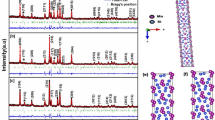Abstract
Boules of the most silicon-rich silicide of manganese, MnSi∼1.73, were grown by the Bridgman method in the composition range from 62.96 to 63.64 at% Si. There are plate-like MnSi precipitates parallel to thec-plane of Mn15Si26 matrix in all boules except at their upper and lower ends. The amount of the MnSi precipitates was about 2 vol%. Measurements of electrical resistivity, Hall coefficient, and thermoelectric power of the boules were made in the temperature range from 77 to 1200 K. Thermoelectronic properties of Mn15Si26 were estimated on the basis of the distribution state of MnSi precipitates in the boule by assuming that metallic MnSi and semiconducting Mn15Si26 alternately crystallized in lamellae. Although the resistivities and thermoelectric powers measured in thec- anda-axis directions of Mn15Si26 showed anisotropy, the former were proportional to exp (4073/T) in the intrinsic region in both directions. The Hall coefficients showed isotropy over the whole temperature range. The degenerate holeconcentration of Mn15Si26 was determined to be 2.1×1027 m−3. Hall mobilities of Mn15Si26 in both thec- anda-axis directions obey aT −3/2-law above 600K. The Hall coefficient calculated from this relationship was in good agreement with the one found for Mn15Si26 in the intrinsic region. The effective-hole masses of Mn15Si26 along thec- anda-axis were found to be, respectively, 15 and 11 times larger than those of a free electron. Assuming that acoustic lattice scattering is dominant and that carriers obey Fermi-Dirac statistics, the temperature dependence of the calculated thermoelectric power was in reasonable agreement with the one estimated for Mn15Si26 in the temperature range from 400 to 1200K.
Similar content being viewed by others
References
R. Kieffer, F. Benesovsky andE. Honak,Z. Anorg. Allg. Chem. 268 (1951) 191.
R. Kieffer, F. Benesovsky andC. Konopiky,Ber. Deut. Keram. Ges. 31 (1954) 223.
A. W. Searcy,J. Amer. Ceram. Soc. 40 (1957) 417.
P. V. Gel'd,Zh. Tekh. Fiz. 27 (1957) 113.
E. N. Nikitin,ibid. 28 (1958) 23, 26.
V. S. Neshpor andV. I. Yupko,Poroshkovaya Metallurgiya 3 (1963) 55.
B. Boren,Arkiv Kemi. Min. Geol. 11A (1933) 1.
M. Hansen, “Constitution of Binary Alloys” (McGraw-Hill Book Co., New York, 1959) p. 953.
V. A. Korshunov, F. A. Sidorenko, P. V. Gel'd andK. H. Davydov,Fiz. Metal. Metalloved. 12 (1961) 277.
L. D. Dudkin andE. S. Kuznetsova,Poroshkovaya Metallurgiya 1 (1962) 20.
O. Schwomma, H. Nowotny andA. Wittman,Monatsh. Chem. 94 (1963) 681.
Y. Fujino, D. Shinoda, S. Asanabe andY. Sasaki,Jap. J. Appl. Phys. 3 (1964) 431.
F. Laves andH. J. Wallbaum,Z. Kristallogr. A101 (1939) 78.
O. Schwomma, A. Preisinger, H. Nowotny andA. Wittman,Monatsh. Chem. 95 (1965) 1527.
A. Boren, “Borides, Silicides and Phosphides” edited by B. Aronsson, R. Lundslrom and S. Rundquist (Methuen and Co., London and New York, 1965).
H. W. Knott, M. H. Mueller andL. Heaton,Acta Cryst. 23 (1967) 549.
G. Zwilling andH. Nowotny,Monatsh. Chem. 102 (1971) 672.
O. G. Karpinskii andB. A. Evseev,Izd. Akad. Nauk SSSR, Neorg. Materialy 5 (1969) 525.
L. D. Ivanova, N. Kh. Abrikosova, E. I. Elagina andV. D. Khvostikova,ibid. 5 (1969) 1933.
N. Kh. Abrikosova andL. D. Ivanova,ibid. 10 (1974) 1016.
L. M. Levinson, General Electric Technical Information Series Number 72CRD111, March, 1972, p. 1.
T. Kojima andI. Nishida,Jap. J. Appl. Phys. 14 (1975) 141.
Idem, J. Crystal Growth 47 (1979) 589.
I. Kawasumi, I. Nishida, K. Masumoto andM. Sakata,Jap. J. Appl. Phys. 15 (1976) 1405.
V. A. Korshunov andP. V. Gel'd,Fiz. Metal. Metalloved. 11 (1961) 945.
D. Shinoda andS. Asanabe,J. Phys. Soc. Jap. 21 (1966) 555.
W. B. Bienert andE. A. Strabek, Proceedings of the IEEE/AIAA Thermoelectric Specialists Conference (Institute of Electrical and Electronics Engineers, New York, 1966) p. 10.
B. K. Voronov, L. D. Dudkin andN. N. Trusova,Kristallografiya 12 (1967) 519.
E. N. Nikitin, V. I. Tarasov, A. A. Andreev andL. N. Shumilova,Fiz. Tverd. Tela 11 (1969) 2389.
E. N. Nikitin, V. I. Tarasov andP. V. Tmarin,ibid. 11 (1969) 234.
E. N. Nikitin andV. I. Tarasov,ibid. 13 (1971) 2938.
I. Nishida,J. Mater. Sci. 7 (1972) 435.
E. N. Nikitin, V. I. Tarasov andV. K. Zaitsev,Fiz. Tverd. Tela 15 (1973) 1254.
V. K. Zaitsev, V. I. Tarasov andA. A. Adilbekov,ibid. 17 (1975) 581.
V. I. Tarasov, E. N. Nikitin andL. N. Shumilova,Izd. Akad. Nauk SSSR, Neorg. Materialy 11 (1975) 1038.
P. V. Gel'd andF. A. Sidorenko, “Silitsid Perekhodnikh Metallov Chetvertogo Perioda (English title: Transition Metal Silicides of the Fourth Period) (Metallurgiya, Moskva, 1971) p. 365, 497.
S. Asanabe,J. Phys. Soc. Jap. 20 (1965) 933.
T. Sakurai, “Crystal Structure Analysis II” (Crysallographic Society of Japan, Tokyo, 1967) p. 99.
E. H. Putley, “The Hall Effect and Related Phenomena” (Butterworth and Co., London, 1960) p. 61.
T. Sakata andT. Tokushima,Trans. Nat. Res. Inst. Metals 5 (1963) 34.
T. Mager andE. Wachtel,Z. Metallkde. 61 (1970) 853.
D. Shinoda, S. Asanabe andY. Sasaki,J. Phys. Soc. Jap. 19 (1964) 269.
I. A. Saltykova, Kh. Gol'dberg, F. A. Sidorenko andP. V. Gel'd,Poroshkovaya Metallurgiya 66 (1968) 73.
I. Nishida,J. Mater. Sci. 7 (1972) 1119.
E. N. Nikitin, V. I. Tarasov andV. K. Zaitsev,Fiz. Tverd. Tela 15 (1973) 1254.
L. P. Hunter,Phys. Rev. 91 (1953) 579.
G. L. Pearson andJ. Bardeen,ibid. 75 (1949) 865.
A. F. Ioffe, “Physics of Semiconductors”, translated by H. J. Goldsmid (Infosearch, London, 1960) p. 305.
J. McDaugall andE. G. Stoner,Phil. Trans. A237 (1938) 67.
Author information
Authors and Affiliations
Rights and permissions
About this article
Cite this article
Kawasumi, I., Sakata, M., Nishida, I. et al. Crystal growth of manganese silicide, MnSi∼1.73 and semiconducting properties of Mn15Si26 . J Mater Sci 16, 355–366 (1981). https://doi.org/10.1007/BF00738624
Received:
Accepted:
Issue Date:
DOI: https://doi.org/10.1007/BF00738624



